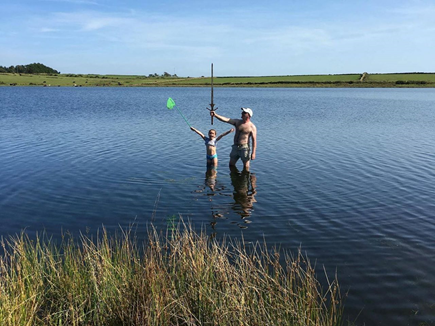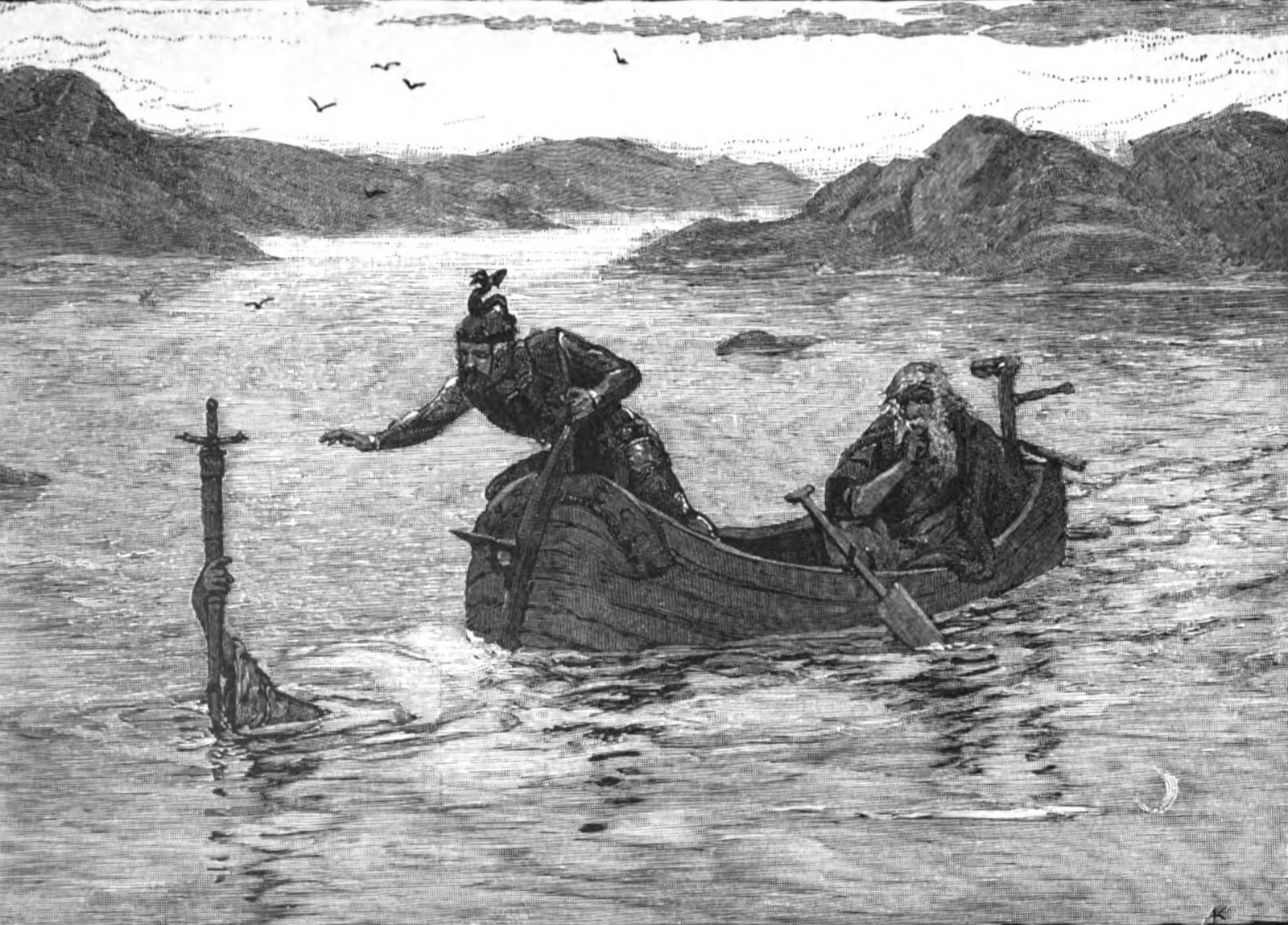Finding Excalibur
The strange tale about the time Excalibur was found, but nobody cared to notice!
In 2017 a remarkable thing happened, Excalibur was found. Strangely, nobody appeared to give a hoot. It seemed like something straight out of a fairy tale. A little girl finds a sword in that very lake, where legend has it that Excalibur was dropped, the most legendary sword of all world literature, the sword of Arthur, the once and future king. (I mean, who besides Viking nerds or Scandinavians has ever heard about the swords Gram or Tyrfing?) The Lady of the Lake chose a little girl and bestowed upon her a badass medieval sword – and then what? It appears that close to zero animist attention flowed toward this beautiful piece of living high mythology.
I present here some thoughts on this strange and remarkable event, both the event of its rediscovery and curiousness of the near silence with which it was met. As background, I will start with a description of a parallel tale of how a symbol that emerges from water can be empowered and charged.
In the early 18th century , three fishermen netted a small inconspicuous statue from the waters of the Paraíba river in Brazil. The statue depicted a black Our Lady of the Immaculate Conception (1). In Brazil, it is not uncommon to dispose of idols by leaving them in nature, typically with a sacrifice to feed the spirit in the object on its return journey to the force it manifests. It is therefore natural that one would give such a saint figurine back to the fresh water from where she comes—this entity is a form of the West African Orisha goddess Oshum, a deity commonly worshipped in Brazil. The discovery of such a statue may not seem particularly remarkable, but according to legend the professional fortunes of the three fisherman suddenly changed—formerly empty, their nets grew fat with fish.
So, although this find is not particularly miraculous in the grand archaeological scheme of things—or even especially improbable—the object’s discovery was still enough for religious personification to kick in. The ascent of Oshum, the fresh water goddess, from the river, bringing bountiful fortune along with her, was a religiously charged moment and the community did not let this go unnoticed. A goddess had shown face, and a new non-human subject came into being, the Nossa Senhora Aparecida, ‘Our Lady (that) Appeared’. The newly surfaced figurine became the object of a new deity, a new manifestation of Oshum.

The little black figure surrounded by gold.
Her presence started to give meaning to accounts of healings, to political projects such as national identity and black liberation as well as to many mundane concerns of normal people. In short, a new, yet old, deity emerged from the riverbed. Here is the temple they build for her

The Basilica of the National Shrine of Our Lady of Aparecida, São Paulo
Let us now turn to look at a very similar event, which happened in Cornwall in 2017. A seven year old Cornish girl named Matilda Jones went for a swim in Dozmary Pool in Bodmin Moor. According to legend, this is where the Lady of the Lake recieved back the Excalibur, which was flung in this lake. Jones saw something blinking in the water. It was a sword, a big medieval sword.
What a moment of hierophany—it’s nothing less than a glimpse of the sacred! A little girl pulling up from those very waters, that quintessential, divine symbol of today’s best-known hero of Northern European legend. However, it's as if nobody really saw that moment! Of course, I can relate. I, myself, have a hard time seeing it—seeing Excalibur there. Still, I just know that it was supposed to be there. We are somehow supposed to have that capacity—as the Brazilians in the example above who found a little statuette and experienced a goddess ascending from the water. Why it is so difficult for us to see this ? - to see the little girl fishing with her net, finding the sword of swords, the Caladvwlch, the most eminent symbol of just, kind, and legitimate power.

Upon the sword’s discovery, some speculated that the sword had perhaps begun its existence as a prop from a community theatre or a movie recording (2). And a Celtic culture enthusiast claims that he was the one who threw the sword in the lake as a symbolic act honoring legend (3). Note how these options are in fact ritualizations that are consistent with the sword as Excalibur. One might even say that they are invocations of Excalibur as the sword, similar to the placing of the little saint statue back to the river water whose power the figurine and deity represents. In the moment when the Lake gives up the sword, this invocation seems affirmed in exactly the same way as Oxum returned to those fishermen with the appearance of the little inconspicuous statuette.
But then what — ?!
Where were the crowds of sick peregrinating on their knees in prayer to the Lady of the Lake? Where was the sudden upsurge in Cornish or Welsh independence movements? Was there an outcry to have the sword included in the paraphernalia of the British monarchy? It didn’t seem like the House of Windsor bothered to consider that the most sublime of all British symbols of royalty just popped into everybody’s face after having rested in Avalon for one and a half millennia. Was there even a hint that anybody saw this monumentally mythic moment as relevant beyond mere coffee table curiosity on click-bait websites? - or the faintest suggestion that King Arthur might return and give justice to the suffering millions?
I think the reason for this silence is simple disenchantment. Today we disconnect our symbolic experiential world of meaning from the material world. If we should really believe that something was Excalibur we would need a very different kind of mythology. Let me try to suggest a mythology for what we would perceive as the real Excalibur.
Today we would perhaps need a blade found in a grave that we might hypothetically discover belonging to that 5thcentury Romano-Celtic warlord, which some scholars believed to have been the historic foundation that developed into what we know today as the legend of King Arthur—perhaps the one commemorated by the famous Artognou stone at Tintagel.
But how does that even make any sense?! If indeed that warlord ever existed, he would have precious little to do with legend surrounding King Arthur. He wasn’t a 13thcentury knight, which is usually how we image King Arthur (4). As far as we can tell, this historic individual didn’t have any round table, didn’t know anybody named Merlin or any medieval knightly code.
The time where these things got attached to Arthurian legendry lies almost a millennia after the historic figure. If Arthur existed, then he lived as historically distant from knights in shining armor as we do today from the Icelandic chronicler Snorri Sturluson, who wrote after the Viking Age. This man might actually have had a longsword, but did he name it (5)? Did Romano-Celtic Britons even regard swords as symbols of particular power, or just as standard equipment for Roman auxiliary troops? Was the man actually regarded as a king?
Well, let us imagine that we did find that grave and in the grave there was the remains of an iron age sword, lying beside this warlord. Would that in a meaningful sense be the Excalibur? It is highly uncertain if any of the meanings that we invest in the name Excalibur have any association at all with that little patch of iron age Romano-Celtic rust.
No! Excalibur is primarily a mythic concept and its most meaningful existence lies in the animist perception and ritualization. If we want to find Excalibur, that is where we need to look! We need to be able to appreciate that moment of hierophany, the moment where Excalibur is found. If we want to enable ourselves to find Excalibur, we need to find the capacity that the Brazilians discussed above displayed to empower and charge such a moment with meaning, subjectivity, and power, so that we may appreciate the animism in that moment where one Matilda Jones pulled King Arthur’s sword from the Dozmary Pool.
_____________________________________________
Thank you to J Stanley Hopkins for language support.
Attributions:
The Lady of the Lake gives Excalibur to King Arthur
Alfred Kappes
https://commons.wikimedia.org/wiki/File:Ladyofthelake1.jpg
public domain
The Basilica of the National Shrine of Our Lady of Aparecida, in Aparecida, São Paulo
https://commons.wikimedia.org/wiki/File:Frente_da_Bas%C3%ADlica_de_Nossa_Senhora_Aparecida,_Aparecida_SP.JPG
HVL - https://commons.wikimedia.org/wiki/User:HVL
(CC BY 3.0)

